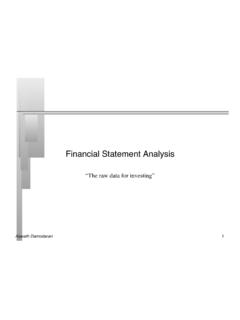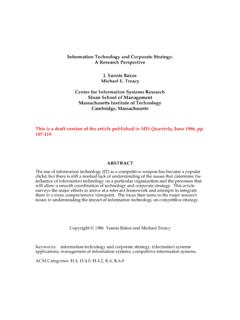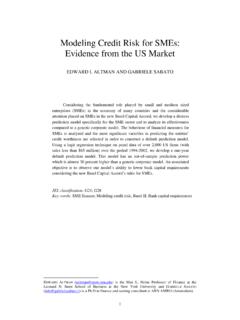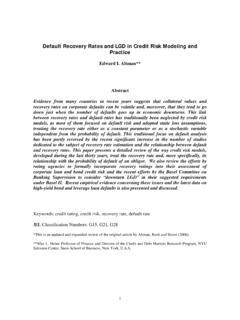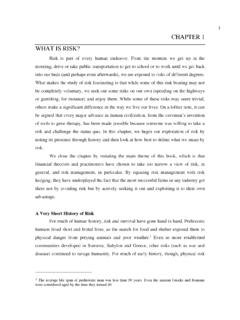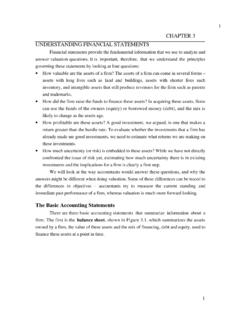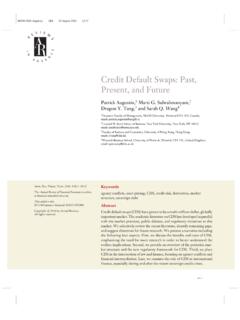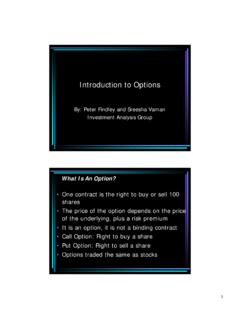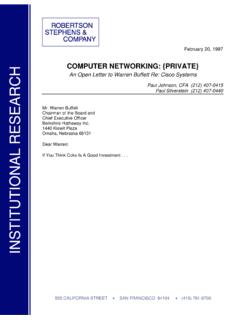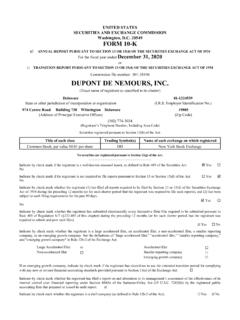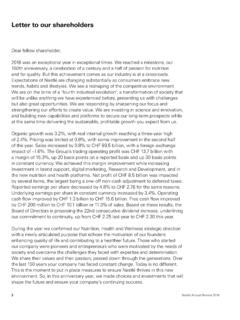Transcription of Corporate Finance: Capital Structure and Financing Decisions
1 Aswath Damodaran1 Corporate Finance: Capital Structureand Financing DecisionsAswath DamodaranStern School of BusinessAswath Damodaran2 First PrinciplesnInvest in projects that yield a return greater than the minimumacceptable hurdle rate. The hurdle rate should be higher for riskier projects and reflect thefinancing mix used - owners funds (equity) or borrowed money (debt) Returns on projects should be measured based on cash flows generatedand the timing of these cash flows; they should also consider both positiveand negative side effects of these a Financing mix that minimizes the hurdle rate and matches theassets being there are not enough investments that earn the hurdle rate, return thecash to stockholders.
2 The form of returns - dividends and stock buybacks - will depend uponthe stockholders : Maximize the Value of the FirmAswath Damodaran3 The Objective in Decision MakingnIn traditional Corporate finance, the objective in decision making is tomaximize the value of the narrower objective is to maximize stockholder wealth. When thestock is traded and markets are viewed to be efficient, the objective isto maximize the stock other goals of the firm are intermediate ones leading to firm valuemaximization.
3 Or operate as constraints on firm value Damodaran4 The Classical Objective FunctionSTOCKHOLDERSM aximizestockholderwealthHire & firemanagers- Board- annual MeetingBONDHOLDERSLend MoneyProtectbondholderInterestsFINANCIAL MARKETSSOCIETYM anagersRevealinformationhonestly andon timeMarkets areefficient andassess effect onvalueNo Social CostsCosts can betraced to firmAswath Damodaran5 What can go wrong?STOCKHOLDERSM anagers puttheir interestsabove stockholdersHave little controlover managersBONDHOLDERSLend MoneyBondholders canget ripped offFINANCIAL MARKETSSOCIETYM anagersDelay badnews or provide misleadinginformationMarkets makemistakes andcan over reactSignificant Social CostsSome costs cannot betraced to firmAswath Damodaran6 When traditional Corporate financial theorybreaks down, the solution is.
4 NTo choose a different mechanism for Corporate governancenTo choose a different objectivenTo maximize stock price, but reduce the potential for conflict andbreakdown: Making managers (decision makers) and employees into stockholders By providing information honestly and promptly to financial marketsAswath Damodaran7An Alternative Corporate Governance SystemnGermany and Japan developed a different mechanism for corporategovernance, based upon Corporate cross holdings. In Germany, the banks form the core of this system.
5 In Japan, it is the keiretsus Other Asian countries have modeled their system after Japan, with familycompanies forming the core of the new Corporate familiesnAt their best, the most efficient firms in the group work at bringing theless efficient firms up to par. They provide a Corporate welfare systemthat makes for a more stable Corporate structurenAt their worst, the least efficient and poorly run firms in the group pulldown the most efficient and best run firms down. The nature of thecross holdings makes its very difficult for outsiders (includinginvestors in these firms) to figure out how well or badly the group Damodaran8 Choose a Different Objective FunctionnFirms can always focus on a different objective function.
6 Exampleswould include maximizing earnings maximizing revenues maximizing firm size maximizing market share maximizing EVAnThe key thing to remember is that these are intermediate objectivefunctions. To the degree that they are correlated with the long term health and valueof the company, they work well. To the degree that they do not, the firm can end up with a disasterAswath Damodaran9 Maximize Stock Price, subject to ..nThe strength of the stock price maximization objective function is itsinternal self correction mechanism.
7 Excesses on any of the linkageslead, if unregulated, to counter actions which reduce or eliminate theseexcessesnIn the context of our discussion, managers taking advantage of stockholders has lead to a much moreactive market for Corporate control. stockholders taking advantage of bondholders has lead to bondholdersprotecting themselves at the time of the issue. firms revealing incorrect or delayed information to markets has lead tomarkets becoming more skeptical and punitive firms creating social costs has lead to more regulations, as well as investorand customer Damodaran10 The Counter ReactionSTOCKHOLDERSM anagers of poorlyrun firms are puton More activistinvestors2.
8 Hostile takeoversBONDHOLDERSP rotect themselves1. Covenants2. New TypesFINANCIAL MARKETSSOCIETYM anagersFirms arepunishedfor misleadingmarketsInvestors andanalysts becomemore skepticalCorporate Good Citizen Constraints1. More laws2. Investor/Customer BacklashAswath Damodaran11 Corporate Governance TestsnAre there voting and non-voting shares? The existence of shares with different voting rights is a direct strike againststockholder power because it allows power to be weilded disproportionately. If the voting shares are held predominantly by the incumbent managers of the firmor a family the problem is Charter If the Corporate charter contains provisions against hostile takeovers, corporategovernance will be negatively imposed by the state If hostile acquisitions are prevented or impeded by state laws and restrictions, stockholder power is constraints If the Capital markets and Financing systems are not supportive of hostile takeovers.
9 stockholder power will be Damodaran12 The Financing Decision: Where it fits in the bigpicturenInvest in projects that yield a return greater than the minimum acceptablehurdle rate. The hurdle rate should be higher for riskier projects and reflect the Financing mixused - owners funds (equity) or borrowed money (debt) Returns on projects should be measured based on cash flows generated and thetiming of these cash flows; they should also consider both positive and negativeside effects of these a Financing mix that minimizes the hurdle rate andmatches the assets being there are not enough investments that earn the hurdle rate, return the cash tostockholders.
10 The form of returns - dividends and stock buybacks - will depend upon thestockholders : Maximize the Value of the FirmAswath Damodaran13 Debt: The Basic Trade OffAdvantages of BorrowingDisadvantages of Borrowing1. Tax Benefit: Higher tax rates --> Higher tax benefit1. Bankruptcy Cost:Higher business risk --> Higher Cost2. Added Discipline:Greater the separation between managersand stockholders --> Greater the benefit2. Agency Cost:Greater the separation between stock-holders & lenders --> Higher Cost3.
